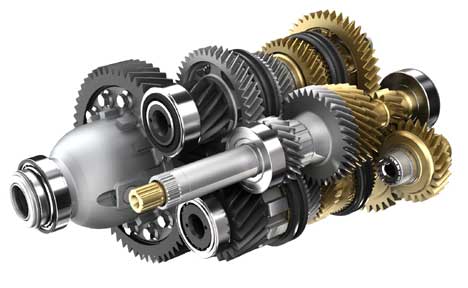Ford is finally joining the in-crowd of companies to offer a direct-shift DSG type gearbox in America starting in the 2010 model year. Long kept as a high-end option in European luxury and sports cars, the new six-speed dual clutch “PowerShort” transmission will appear next year in new small car models to start.
Direct shift transmissions offer the fuel efficiency of a manual gearbox with the convenience and ease of a premium automatic transmission. What makes the direct shift transmission or what Ford terms as PowerShift great is that it provides the full comfort of an automatic with a more sophisticated driving dynamic. This is due to uninterrupted torque from the dual-clutch technology, which consists essentially of two manual transmissions working in parallel, each with its own independent clutch unit. One clutch carries the uneven gears – 1, 3 and 5 – while the other the even gears – 2, 4 and 6. Subsequent gear changes are coordinated between both clutches as they engage and disengage for a seamless delivery of torque to the wheels.
“PowerShift represents a true competitive advantage for Ford and is one of the many technologies that will help our global small car platforms set a new world standard for efficiency and drive quality,” said Barb Samardzich, vice president, Global Powertrain Engineering, who announced PowerShift’s production timing at the 2009 Automotive News World Congress. “This advanced six-speed is an improvement over today’s automatic transmissions in terms of fuel economy, while providing customers an even more fun-to-drive experience.”
Ford says it has committed that almost 100 percent of its transmissions will be advanced six-speed gearboxes by 2013. This would suggest that even rear-wheel drive cars like the Mustang will benefit from this new technology at some point in the future, a long desired feature for driving enthusiasts.
In North America, a dry-clutch derivative of Ford’s European wet-clutch PowerShift transmission will be used for added efficiency and durability. A dry clutch transmits power and torque through manual transmission clutch facings, while most automatic transmissions utilize wet clutch plates submerged in oil. As a result, the dry-clutch PowerShift transmission does not require an oil pump or torque converter, providing superior mechanical efficiency.
“A dry clutch is a real sweet spot for lighter vehicle applications,” said Piero Aversa, manager, Ford Automatic Transmission Engineering. “PowerShift is more efficient, it saves weight, is more durable, more efficient and the unit is sealed for life, requiring no regular maintenance.”
Some of the benefits of this new transmission are:
• Neutral coast down – The clutches will disengage when the brakes are applied, improving coasting downshifts and clutch robustness as well as reducing parasitic losses for increased fuel economy.
• Precise clutch control in the form of a clutch slip to provide torsional damping of the engine vibration – This function improves noise, vibration and harshness (NVH) at low engine speeds and enables lower lugging limits for improved fuel economy.
• Low-speed driving or creep mode with integrated brake pressure – This function simulates the low-speed control drivers are accustomed to from an automatic transmission. The amount of rolling torque in Drive and Reverse is precisely controlled, gradually building as brake pressure is released.
• Hill mode or launch assist – Prevents a vehicle from rolling back on a grade by maintaining brake pressure until the engine delivers enough torque to move the vehicle up the hill, providing improved driver confidence, comfort, safety and clutch robustness.
Sounds great to us that Ford is continuing to bring world-class technology to our shores. This is what they meant when they said their recovery will be fueled by new products.

